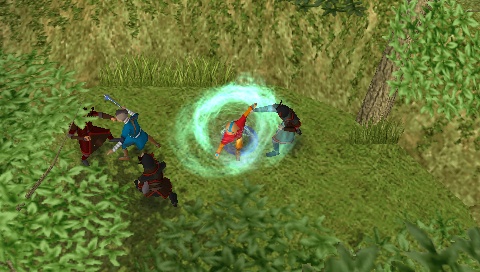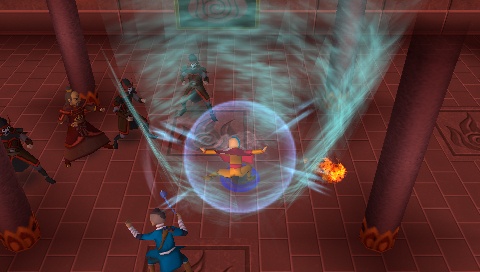Just as the title suggests, Avatar: The Last Airbender for the PSP is a game featuring the characters and locations from Nickelodeon's popular cartoon show. In this hack-and-slash-style RPG, players lead a party of four heroes through multiple portions of the Avatar world, go on quests for the villagers met along the way, and use the experience and items gained from fighting soldiers and fulfilling quests to constantly upgrade the characters' skills and outfit them with new equipment. Overall, the design is solid and sufficiently varied. Anyone that's played similar games, such as Untold Legends, should feel right at home. Fans of the cartoon, meanwhile, will appreciate that the story, characters, and locations in the game ring true to the portrayals in the show.

In the world of Avatar, people known as benders have the ability to cast elemental magic. The world is split into four different nations, each based on the element the nation's inhabitants have mastery over: fire, water, earth, or air. For centuries, the four nations lived in peace. However, one day the Fire Nation began a campaign to conquer the other nations. According to legend, the only person strong enough to stop the Fire Nation is the Avatar, a superbeing with the ability to control all four elements. The game, like the show, follows the travails of Aang, the last airbender and supposed Avatar, on his quest to awaken his powers and bring an end to the war. Since Aang hasn't quite mastered the other elements yet, he enlists his friend, a fighter named Sokka, to tag along. Eventually, two other friends, a waterbender named Katara and an earthbender named Haru, also join Aang's cause. Together, the four heroes set out to visit the different villages in the land to gradually push back the Fire Nation forces and get Aang the training he needs.
Each of the game's seven chapters contains a village and a large surrounding area. Within that area, there are specific people and places that you need to visit in relation to the overall story, but you're free to tackle side quests and build your characters however you see fit along the way. The one catch is that you can only have two characters in your party at any given time, while the other two stay behind at the village. Occasionally, you have to put some thought into how the party is put together. While Sokka's strength is advantageous, for example, Katara's heal ability really comes in handy in areas that are packed with enemies. Of course, since this is a hack-and-slash-style game, you'll constantly encounter Fire Nation soldiers out in the wild that you can exchange fisticuffs with. Battles happen in real time, with you controlling one character and the CPU controlling the other. Generally speaking, the CPU does a good job of dodging and attacking with the hero under its care, leaving you free to concentrate on your own situation. Individual soldiers aren't very strong or fast, so it usually only takes a few punches to get rid of them. Multiple soldiers can gang up on you, though, and sometimes they'll call out for reinforcements. Combat is otherwise straightforward and mainly involves mashing buttons until all of the surrounding enemies are gone. While you may or may not find that whole process boring, the loot and experience that are left behind after each fight certainly justify the time spent exchanging blows.
Like any good hack-and-slash, the PSP version of Avatar: The Last Airbender puts a number of character-development aspects under the player's control. You can pour experience and chi points into upgrading each character's specific attributes and attacks, for example, and outfit them with clothing and jewelry to enhance their overall defense and resistance against certain elements. With the money you earn, you can visit shopkeepers to buy healing items and to fashion together unique clothing from the miscellaneous items you've gathered. Upgrades tend to have a huge impact on how much damage you can dish out and take. Thus, since the two best ways to gain money and experience are to go on side quests and beat up soldiers, it pays to take the time to do so. You'll also get more out of the game if you make it a point to see and do everything. If you stick close to the story, you can breeze through all seven chapters in six hours or so. You won't meet many people or find out as much about Aang that way, though. However, if you build up your characters and try to help out people in distress, you'll perhaps double or triple the time you spend with the game and find out much more about Aang in the process.

Regardless of how you choose to play the game, you'll probably be satisfied with the way it's presented. The third-person perspective makes it easy to keep an eye on both active heroes and to take in the scenery. On the whole, the PSP's 3D capabilities have been put to good use, as the backgrounds and characters are crisp, clean, and richly detailed. Character animation is generally smooth, and all of the different elemental attacks are suitably flashy. Nearly every area seems to have some sort of animated environmental detail to gawk at, such as flaming torches, swaying tree branches, flowing streams, or various weather-related effects. Those details are usually accompanied by the appropriate atmospheric noise. Flames crackle in the background, for example, and the sound of rushing water becomes louder as you move closer to a stream or river. The rest of the audio consists of a good variety of battle sounds and a collection of Far East music that's more often mellow than upbeat. While the story doesn't necessarily tie into any specific episode of the show, fans of the series will still be happy to discover that some key character interactions from the cartoon have made their way into the game. Story scenes in the game are put together to resemble comic book panels, in that when you talk to another character, the viewpoint shifts to show two hand-drawn characters situated above the printed dialogue. Most of the hand-drawn artwork is genuinely top-notch, and some of the reaction poses are downright hilarious, but it seems odd that they didn't record any voice dialogue to accompany the printed text. After all, the characters make comments like "ouch" and "hey, that hurts" constantly throughout the course of the game.
Anyone that's already a fan of the cartoon and owns a PSP won't necessarily go wrong adding the PSP version of Avatar: The Last Airbender to their game collection. For that matter, fans of the hack-and-slash genre that have run out of things to do in Untold Legends or Untold Legends 2 also may want to give the game a try. It's not anything overly special, but it's a solid enough experience to make it recommendable.